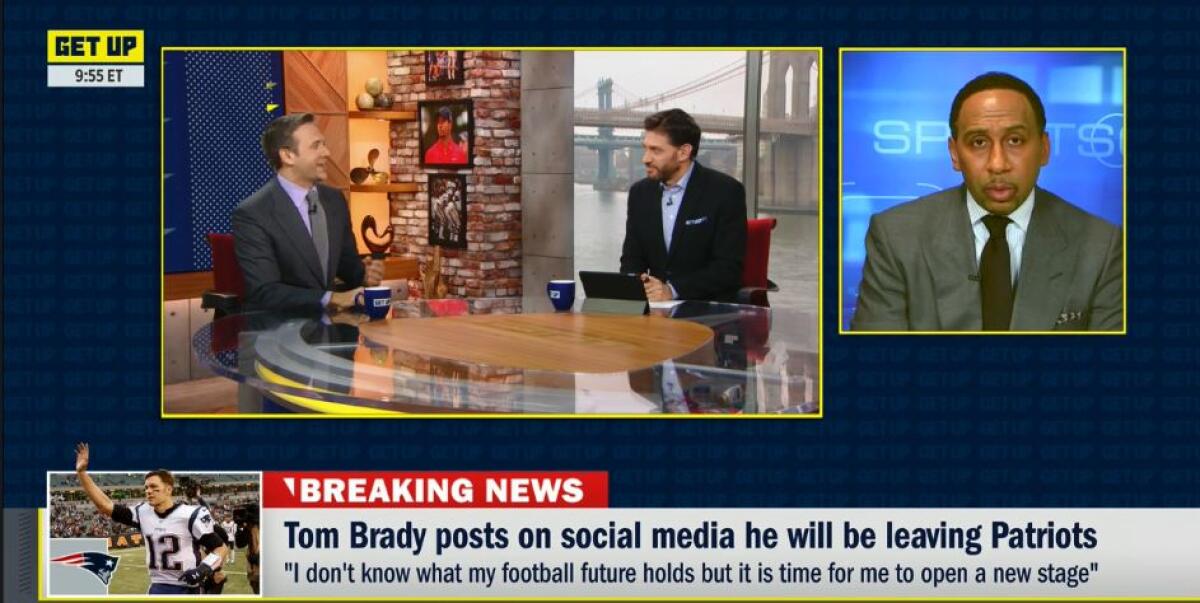The coronavirus threw ESPN a curveball. How the sports giant is changing its game

- Share via
The ‘S’ in ESPN stands for sports. So what happens to one of the most-watched cable networks when its programming staple — live contests — shuts down?
It’s an obstacle the network is facing as the coronavirus pandemic has put an indefinite halt to the NBA and Major League Baseball, which made up the core of ESPN’s live programming over the next few months.
The shutdown of the entire sports world has also meant no fresh highlights for ESPN’s signature news program, “SportsCenter.”
The situation could have major financial implications for parent company Walt Disney Co., which has long relied on huge profits generated by its suite of ESPN channels. The virus outbreak comes at a critical time for for ESPN, which has already seen its profitability fall due to cord-cutting consumers who are canceling or forgoing pay TV subscriptions.
ESPN did not make executives available, but Burke Magnus, executive vice president of programming, acquisitions and scheduling said in an interview posted on the network’s website this week that the company has been focused on finding alternative ways to keep its audience engaged.
Magnus said ESPN remains relevant to fans this week as the NFL league calendar had its official start this week, leading to a spate of news on free agent signings by teams and the blockbuster news that superstar quarterback Tom Brady intends to move on from the New England Patriots.
“We’ve built our schedules with an eye toward that being a major topic of conversation,” Magnus said of the NFL moves.
The company has been talking to leagues about getting permission to run encore presentations of classic games, something fans have been requesting.
ESPN is also developing programming that doesn’t require a full production staff to come to its headquarters and studios in Bristol, Conn., as most of them are working at home to avoid the spread of the COVID-19 virus.
Viewers are being asked to vote online to determine the greatest college basketball player of all time — in a bracket style similar to those used in the canceled NCAA College Basketball tournaments — with the results presented in a special airing Thursday.
While ESPN and other TV networks try to fill the gap created by the public health crisis, financial analysts who follow Disney are watching for any long-term impact on a business that has been weathering the challenges of shifting viewer habits.
ESPN’s lack of live games is projected to lead to a ratings decline of as much as 80% and compound the problems for Disney, which has been reeling on multiple fronts due to the pandemic. Disney’s theme parks are closed around the world, and its cruise ships are stuck in harbors. Movie theater closures have erased another big source of revenue for the company because Walt Disney Studios relies heavily on its box office blockbusters.
Analysts worry that a recession could prevent a return to business as usual, as leisure spending is discretionary and households will have less income for such extras. The challenges come at a time when Disney has more than doubled its corporate debt to $47 billion to pay for its acquisition of much of 21st Century Fox. They also follow a recent changing of the guard as longtime Chief Executive Bob Iger handed the day-to-day operations over to Bob Chapek, who had run Disney’s parks and attractions.
A decade ago, ESPN was distributed in about 100 million homes, but now ESPN and ESPN2 are found in about 84 million pay-TV homes. The reduction means the company is taking in less money in fees received from pay TV distributors — known in the industry as affiliate fees — while programming costs continue to rise.
ESPN has countered the trend with the launch of its over-the-top streaming service ESPN+ — which is an eventual replacement for the traditional pay TV subscription — and the inclusion of its channels on internet-delivered TV services such as Sling and Hulu Plus. Jimmy Pitaro, who took over the reins of ESPN in 2018, has made the network’s availability on digital platforms a priority.
But the virus has delivered an unexpected curveball. Media analyst Michael Nathanson wrote in a research note Tuesday that Disney’s media networks, including ESPN, will likely take in $250 million less in revenue in fiscal year 2020 than anticipated due to the sports cancellations.
Nathanson said that if the rest of the NBA season is canceled, ESPN will lose out on as much as $475 million in advertising revenues. There could also be an additional $150 million decline in ad revenues related to all of the other sports that were shut down through the end of March, including the BNP Paribas Open tennis tournament in Indian Wells, Calif.
Nathanson expects Disney to save hundreds of millions of dollars by not having to pay as much in sports rights, although there will be an investment of as much as $100 million required to program the hours that would ordinarily be devoted to live coverage. “We do think this will be done as efficiently as possible including reusing previously telecast games and specials,” he said.
Todd Juenger, media analyst with Bernstein & Co, has an even rosier view about the cost savings realized from not incurring the cost of live sports programming.
“The shutdown of all organized sporting events is obviously a bad thing for the ESPN family of networks, the SEC network, and newly launched ACC network, as well as ABC broadcast,” Juenger said. “Surprisingly, we believe the near-term impact on segment profits will be more-or-less profit. It could even be profit positive.”
But there is no guarantee that TV rights fees that ESPN has already paid sports leagues will be immediately rebated to ESPN or other networks that carry sports.
Lee Berke, a sports media consultant, said the leagues can also make up for lost games by extending deals, adding programming or granting networks permission to run more commercials.
“What nobody wants to do unless it’s absolutely necessary is give money back,” Berke said. “Most likely there will be tougher discussions down the road. It’s a very rare event, and you’re going to have to deal with it in a variety of ways to make people whole.”
There is also a question of whether cord-cutting will accelerate as ESPN rides out the sports shutdown.
“We do expect some increase in cord-cutting, at least in the near term, from pay-TV subscribers whose main interest is sports, especially for those consumers who have lost their income,” said Juenger. “We expect most of those subscribers will come back. Some will not.”
David Carter, a professor at the USC Marshall School of Business who specializes in the sports business, believes fans will flock back to the games they love when play resumes, as a long hiatus will create pent-up demand for their return.
“These sports fans are incredibly resilient,” Carter said. “They have just an unending appetite for content, especially live content, and they are certainly going to get tired of watching re-runs of curling and drone racing and billiards. And the moment they have a chance to watch something live, it will represent a return to some semblance of normalcy.”
While fan interest is expected to come back when sports competition returns, there could also be a logjam of events in the fall as horse racing’s Triple Crown and the Masters golf tournament have been rescheduled for September alongside the start of the NFL and college football season and Major League Baseball’s pennant races.
That could cause more sports programming to move to streaming in order to accommodate the crowded schedule. Streamers already are getting a boost as media companies shift their movie releases to home viewing.
“It’s going to hasten the day when these networks and these properties move more toward streaming content direct to consumers,” Berke said. “It could change how these deals are done.”
More to Read
Inside the business of entertainment
The Wide Shot brings you news, analysis and insights on everything from streaming wars to production — and what it all means for the future.
You may occasionally receive promotional content from the Los Angeles Times.












